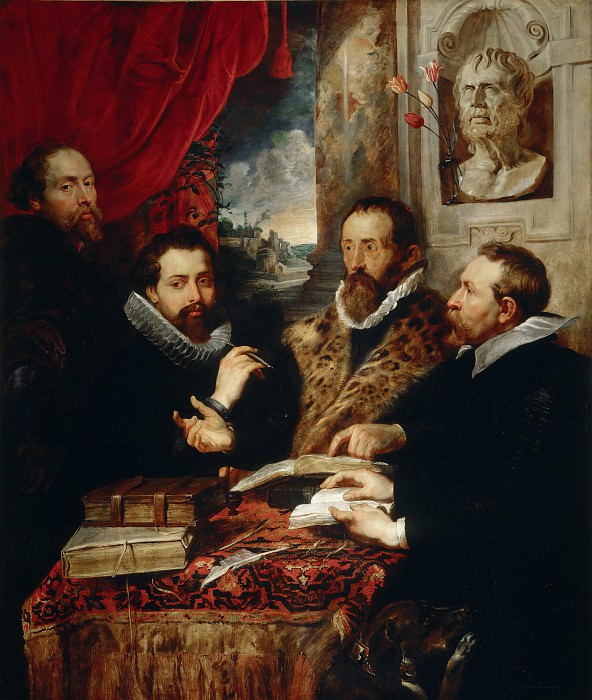Selfportrait with brother Philipp, Justus Lipsius and another scholar Peter Paul Rubens (1577-1640)
Peter Paul Rubens – Selfportrait with brother Philipp, Justus Lipsius and another scholar
Edit attribution
Download full size: 3657×4326 px (3,1 Mb)
Painter: Peter Paul Rubens
The painting of this gifted and talented artist has special significance and value for Rubens himself. "Justus Lipsius and His Disciples" is another title for this painting, and the particularity lies in the fact that the artist painted the most related people in the picture--a brother, his close friend, and the man whose role in their lives was crucial--the teacher Justus Lipsius. The painting depicts a marble sculpture of the Roman philosopher Seneca, with the great teacher and his beloved disciples under his head.
Description of Peter Rubens’s painting The Four Philosophers
The painting of this gifted and talented artist has special significance and value for Rubens himself. "Justus Lipsius and His Disciples" is another title for this painting, and the particularity lies in the fact that the artist painted the most related people in the picture--a brother, his close friend, and the man whose role in their lives was crucial--the teacher Justus Lipsius.
The painting depicts a marble sculpture of the Roman philosopher Seneca, with the great teacher and his beloved disciples under his head. The artist also depicted himself on this canvas, but he is a bit distant from the participants in the philosophical discussions. The artist is depicted as an ordinary listener, ready to indulge in these intelligent and philosophical speeches for a long time. The painting is done in a rich color palette and there is even luxury and some pomposity. The luxury lies in such details as the column made of marble, the curtain made of luxurious and bright drapes. In the picture you can see how next to the bust of the Roman painter there is a transparent vase with beautiful and bright tulips.
The painting is interesting in that not only does the teacher appear to us as a bright personality, but the students also have their individuality and characteristics and differences. Looking at the painting, one can notice that the artist puts kinship and friendship in the first place, because he depicted the people dear to his heart in the foreground, and himself removed from them.
In general, the emotions that the painting conveys immerses the observer in the inner world of the participants in a philosophical conversation.
Кому понравилось
Пожалуйста, подождите
На эту операцию может потребоваться несколько секунд.
Информация появится в новом окне,
если открытие новых окон не запрещено в настройках вашего браузера.
You need to login
Для работы с коллекциями – пожалуйста, войдите в аккаунт (open in new window).

![Peter Paul Rubens - The Three Graces [Workshop]](http://cdn.gallerix.asia/j/_EX/754398988/3017.webp)


















COMMENTS: 1 Ответы
ПРЯНИК:
1. Возможность ознакомится с картиной!
2. Возможность скопировать картину ВЫСОКОГО качества!!! БОЛЬШОЙ СПАСИБО
3. Адрес оригинала картины!!!
ВОЗЖИ
1. нет наименования картины на языке оригинала (или английском? – )
2. НЕТ Рассказа о картине (или ссылки на сайт, где это есть) Например меня интересует художник Абрахам Яссенс (музей Платин-Моретус, Антверпен) с картины которого списал Рубенс Юстуса Липсиуса (1547-1606) Четыре философа
3. ну и не забывайте про капитализм – я бы заплатил NN-ую сумму за компакт=диск со ВСЕМИ картинами Рубенса (в частности)!!! с рассказом о картине. (возможно у вас есть – поищу, но на странице 4 философа не нашел)
4. Слабовата ссылка на альбом Рубенса – может иконку NN картин находят одна на другую и надпись на иконке ВСЕ КАРТИНЫ РУБЕНСА
SATOR. ucoz.ru
ПысПыс
Кстати Я сам автор шедевра XXI века -
http://sator.ucoz.ru/index/shedevr_xxi_veka/0-364
что дает мне уверенность увидеть Шедевр на вашем сайте
You cannot comment Why?